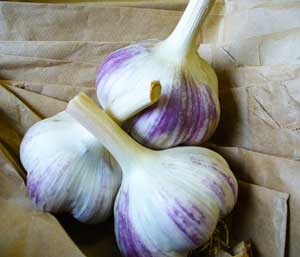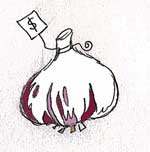Garlic Diversity and Varieties
Check Out the Story of How Gourmet Garlic Reached the USA
One of the most exciting things about growing gourmet garlic is that there are literally hundreds of named cultivars/strains of garlic available. I was unable to find a definite source for exactly how many strains of garlic are available worldwide but it is likely somewhere around 500-700 strains. This number is compounded by the fact that the same variety of garlic can look different in different areas of the country or even under different conditions in the same farm. 
Picture: Colorful Siberian garlic bulbs rest on paper bags.
Garlic responds very elastically to environmental conditions such as location, soil, weather, and weed pressure. Some of the traits that change the most with environmental factors are bulb color and size. We have noticed that clove size, clove number and bulb size are extremely dependant on growing conditions and seed stock vitality and size (and how green the grower's thumb seems to be). Traits that normally remain stable are clove arrangement within the bulb, scape presence, bulbil number and appearance, and clove wrapper traits.
Confusion can reign since common names of garlic can be similar or identical among different strains of garlic. For example, we grow a garlic called German Red that is in the Rocambole family. Often people ask us if it is the same as German White, a Porcelain garlic grown mainly in the Northeast. In addition, until recently there was disagreement over how many subvarietal groups of garlic were currently being grown.
In 2003, the different subvarietal groups or families of garlic were identified through genetic analysis by two different scientists on opposite sides of the world. Besides proving that great minds think alike, it answered the burning question of how many garlic varieties are really out there (I know that a lot of you were really aching to know that!). If you are interested in garlic genetics, please see our information on the ten garlic families and read more about garlic classification.
How Garlic Reached the USA
The USA wasn't always a diverse landscape of garlic varieties. Although there have always been some heritage varieties handed down from generation to generation, most of the different hardneck garlics found their way to the USA in 1989 during the collapse of the Soviet Union. Botanists at the USDA had been asking (actually whining and begging) to get into the Caucasus region of the former USSR for quite a while. Permission was always denied because of the number of military installations in the area. Finally, as the old USSR empire fell into decline, the USDA was suddenly invited in to pick over the native Alliums.
Delightedly by the opportunity USDA personnel traveled to the region. Under armed guard and allowed to travel only at night, they visited villages in the region and bought garlic. I can just imagine those transactions:
 Ivan (through translator): "It was a moonless night when the militsiya (Russian police) showed up with these odd American visitors. At first I didn't understand what they wanted but the translator explained that they were there to see my prize winning chesnok (Russian term for garlic).
Ivan (through translator): "It was a moonless night when the militsiya (Russian police) showed up with these odd American visitors. At first I didn't understand what they wanted but the translator explained that they were there to see my prize winning chesnok (Russian term for garlic).
After I brought out several bulbs I could see that the foreigners were getting very excited. They offered to exchange a lot of American money for all the bulbs. I was puzzled, but if the amerikanskiy (Americans) wanted to pay way too much money for a few heads of garlic who was I to argue. After all I had won first prize at the village yarmarka (fair) last year for best tasting bulbs; even if my wife refuses to cook them because she says they stink up the house."
Sasha (Ivan's wife): "I never thought that Ivan would sell any of those smelly chesnoks of his, now he has become unbearable to live with. All day long my idiot husband goes around telling everyone that his garlic was so great that people traveled all the way from America to buy it. And every time he tells the story the price they paid him increases! At the taverna last night he told Elana's mother-in-law that the amerikanskiy had given him one donkey for each bulb along with $100 in American money!"
To simplify things, the collected garlic was named after the town it was bought in (which explains a lot about why none of us can pronounce or spell the name of our own crop). Since the USDA had no place to grow it's newly acquired booty, they contracted with local farmers to grow the garlic for a share of the harvest. These farmers started trading and selling their garlic locally which is how the varieties spread.
